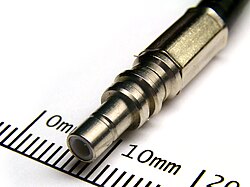 Custom SMB jack connector crimped to a 5 mm coaxial cable | |||
| Type | RF coaxial connector | ||
|---|---|---|---|
| Production history | |||
| Designed | 1960s | ||
| Manufacturer | Various | ||
| Cable | Coaxial | ||
| Passband | Typically 0–4 GHz | ||
SMB (SubMiniature version B) connectors are coaxial RF connectors developed in the 1960s. SMB connectors are smaller than SMA connectors.
Contents
They feature a snap-on coupling and are available in either 50 Ω or 75 Ω impedance. They offer excellent electrical performance from DC to 4 GHz.
An SMB jack has a male center pin, while an SMB plug has a female basket. [1] [2]
Connectors are available for two SMB cable sizes:
- Cable 2.6/50+75 S (3 mm outer / 1.7 mm inner diameter) and
- Cable 2/50 S (2.2 mm outer / 1 mm inner diameter)